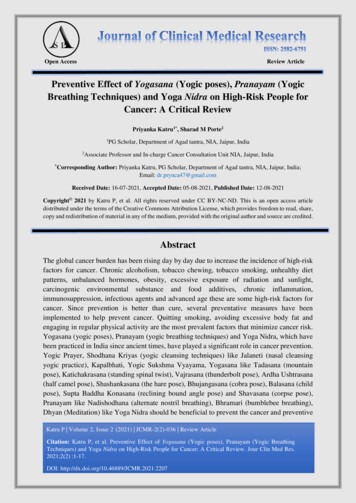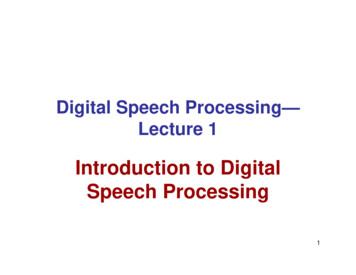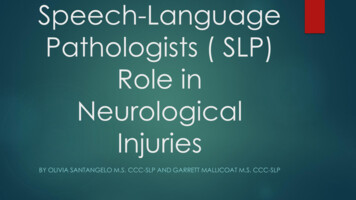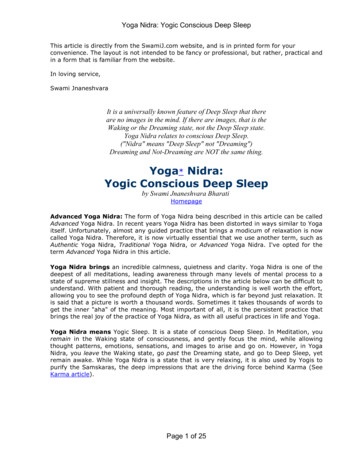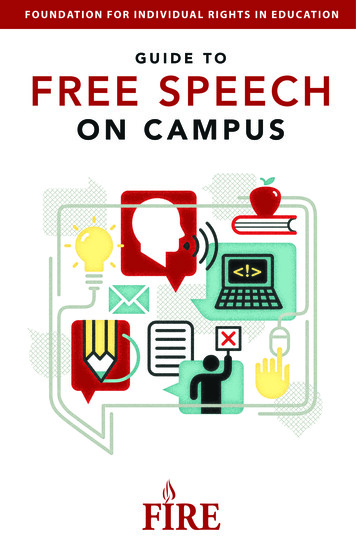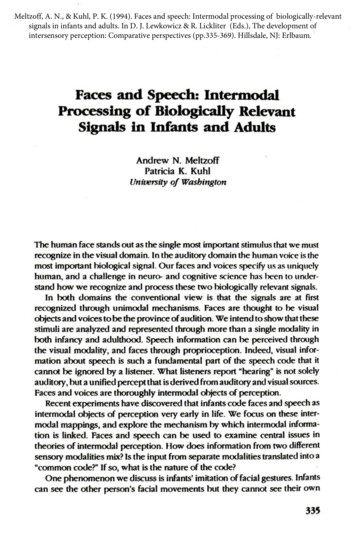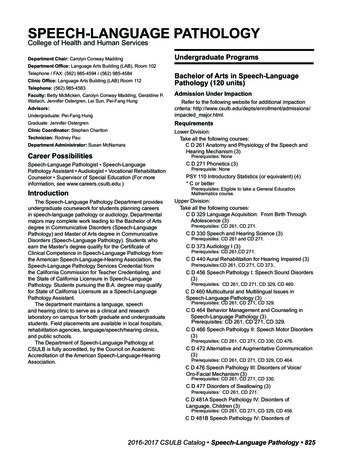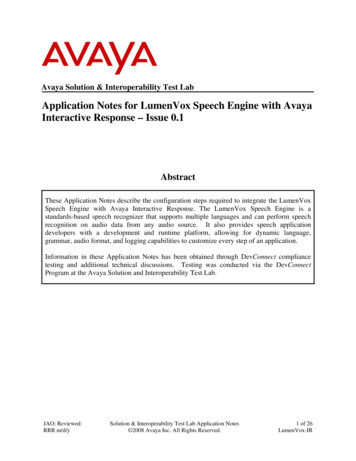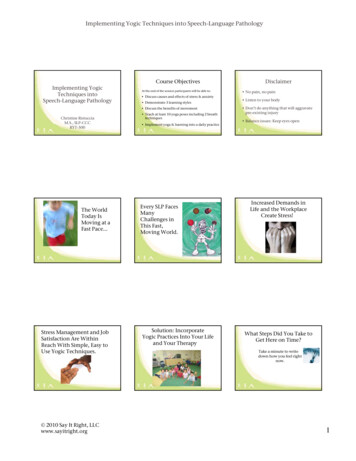
Transcription
Implementing Yogic Techniques into Speech-Language PathologyCourse ObjectivesImplementing YogicTechniques intoSpeech-Language PathologyDisclaimerAt the end of the session participants will be able to: No pain, no pain Discuss causes and effects of stress & anxiety Demonstrate 3 learning styles Discuss the benefits of movement Teach at least 10 yoga poses including 2 breathtechniquesChristine RistucciaM.S., SLP-CCCRYT-500 Listen to your body Don’t do anything that will aggravatepre-existing injury Balance issues: Keep eyes open Implement yoga & learning into a daily practice245Solution: IncorporateYogic Practices Into Your Lifeand Your TherapyStress Management and JobSatisfaction Are WithinReach With Simple, Easy toUse Yogic Techniques.6What Steps Did You Take toGet Here on Time?Take a minute to writedown how you feel rightnow.7 2010 Say It Right, LLCwww.sayitright.orgIncreased Demands inLife and the WorkplaceCreate Stress!Every SLP FacesManyChallenges inThis Fast,Moving World.The WorldToday IsMoving at aFast Pace 3891
Implementing Yogic Techniques into Speech-Language PathologyTune In to Your BreathWatch this beautiful sunriseas you practice breathing.Breathe in andbelly expandsout like aballoon, breathin and bellydeflates.1011How Did It Feel to PracticeLong Deep Breathing?Tune in As a Group12What is Yoga?We are going to chant the word:Long, deep breathing calmsthe mind and soothes thenervous system.“SPEECH”in unison to unify ourselves as a group.13What are theBenefits of Yoga?15Pretend you are walking ina forest on a beautiful,sunny day. Suddenly yousee this What is stress?16 2010 Say It Right, LLCwww.sayitright.org1417182
Implementing Yogic Techniques into Speech-Language PathologyWhat causes stress – Bear –Original StressorPhysiological Response to“Fight or Flight”“Fight or Flight” Response to threat Can be positive for short emergencies Is negative when in a chronic state. Response is the body preparing itselfto deal with emergencies19The Autonomic NervousSystem Has Many Functions20Autonomic Nervous SystemStimulates Either the “Fightor Flight” or “RelaxationResponse”22Stress Can Be Caused byAttempting to Do Two ThingsSimultaneously 2010 Say It Right, LLCwww.sayitright.orgWhat Causes Stress?23When Every Moment is filledwith mental stimulation: LeftBrain Thinking Results.Left Brain ThinkingFastLogicalLinearAnalytical252124Our Kids Are Filled WithCONSTANT MentalStimulationRight Brain ThinkingIntuitiveCreativeNon-linear26273
Implementing Yogic Techniques into Speech-Language PathologyStressDifferent Types of Stress Can be short termor chronicPositive Stress(Eustress) Can come fromany situation orthought thatmakes you feel:frustrated, angry,nervous or anxious Weddings Celebrations WinningSympathetic Nervous SystemNegative Stress(Chronic Stress) Stress without restoration Constant stimulationleads to constant “fight orfight” Trauma2829“Rest and Digest”Parasympathetic NervousSystemPhysical Symptoms of Stress30Physiological Response toParasympathetic Nervous System Irregular breathing Sweaty Palms Racing heartbeat Digestive issues – stomach ache, nausea Attention issues Tired Sick often31What Activates theParasympathetic NervousSystem?34 2010 Say It Right, LLCwww.sayitright.org32Comparison of theSympathetic andParasympathetic NervousSystems33The purpose of theAutonomic Nervous System35364
Implementing Yogic Techniques into Speech-Language PathologyWatch this serene or closeyour eyes as you breathe.Let’s Take Time for Some Long,Deep Breathing.Tune in to your breath37Speech and Its Relationshipto Breathing38Breathing Can AffectStress Levels Speech and Yoga: the link is breath. Upper chest breathing You need breath to produce speech. Shallow breathing(Sumar,2000)39Practicing Yogic Breathing:Coherent Breathing Breath holding Reverse breathing40Yoga: BreathingIncoherent Breathing41Look for Sign of IncoherentBreathing With Your StudentsContra-indicated breathing can add tothe anxiety of your students or mayeven be a MAJOR contributor of theanxiety. Rapid and shallow Live in a sympathetic dominant state Constant state of stress: “Fight or Flight” Counterpart to state of the mind. If you arestressed, you are holding your breath.43 2010 Say It Right, LLCwww.sayitright.org4442Breathing Reflectsthe State of Your MindIf you are relaxed, yourbreath is slow and deep.If you are stressed,breath is shallow andyou may even beunconsciously holdingyour breath.455
Implementing Yogic Techniques into Speech-Language PathologyThere Are Various Types ofBreathing PracticesYoga: BreathingAlternate NostrilYoga: BreathingDiaphramatic Breathing Normal breathing Nostril breathing Deep Breathing – Slows respiration andautonomic functions Conscious (purposeful) breathing Ujjaii breathing46What are theWays to Deal with Stress?47What Causes You to FeelAnxious?48The Definition of AnxietyA feeling of fear/apprehension.What is Anxiety for you?49Kids Have Stress Too5051People Think CreativelyWhen Relaxed.Kids Have Stress Too52 2010 Say It Right, LLCwww.sayitright.orgThe source of theuneasiness is not alwaysknown or recognized,which can add to thedistress felt.53546
Implementing Yogic Techniques into Speech-Language PathologyStress/ Anxiety and itsRelationship to SLI KidsStress Can Affect LearningRestricts thenumber of newlygenerated neuronsin theHippocampus(short term storageof memory for newinformation).Fact About Stress/Anxietyand SLI KidsChildren with SLIproblems are 3 xmore likely to sufferfrom social anxiety(social phobia) thanchildren withoutproblems.Children with SpeechLanguage Impairments(SLI), includingexpressive languagedisorders, were rated asmore withdrawn andanxious than peers.(Brenner, 2002)(Benner, 2002)5556People Need an Outlet toRelieve Their StressAnxiety Affects Emotions57Brain Development & StressLong-Term ConsequenceAnxiety affectsStress is increased ifthere is no outlet forfrustration.Limbic system (emotions) whichReleases adrenaline which(Louise Goldberg, 2004)Activates the Sympathetic Nervous System58We Expect Our AnxiousSpeech Kids to Performin TherapyWhen under physical or emotionalstress, the Sympathetic NervousSystem releases cortisol which underhigh levels can cause brain cells todie and reduced the connectionsbetween cells in certain parts of thebrain.59We Tell Anxious Kidsto Relax WithoutTeaching Them60Journal about What CausesStress in You Life.If we don’tteach themto relax,who will?Most of the time we aren’t relaxed ourselves.61 2010 Say It Right, LLCwww.sayitright.org62637
Implementing Yogic Techniques into Speech-Language PathologyWhat does Yoga Have to dowith Speech Therapy?Although It Appears As ThoughEverything Is Going Fine Withthe Students,What does Yoga Have to dowith Speech Therapy?Studies have shown that many speechlanguage kids have: Motor-skill deficiencies Language delays Anxiety Social skill immaturityWe Have a Serious ProblemThat Needs to Be Addressed Some have aggressive behavioral tendencies64Incorporate Yogic Practices IntoYour Life and Your TherapyOcean BreathYoga Break67Yoga Consists of Physical andMental Relaxation Exercises Breathing – purposeful Calming – Peaceful – Restorative –7066What Is Your Impression andExperience of Yoga?It will help you and your anxious speech kids relax.6869Yoga Incorporates Visual,Auditory and KinestheticLearning StylesWhy use Yoga in Speech?Yoga teacheschildrenrelaxationstrategies thatthey can useat school andthroughouttheir entirelives. Exercise – postures 2010 Say It Right, LLCwww.sayitright.org65 Incorporates multiple intelligences(body, mind and spirit) and learningstyles Breath and exercise Keeps nervous system elastic and ableto deal with stress71728
Implementing Yogic Techniques into Speech-Language PathologyWhat Do You DoWhen You First Get an Object?Types of Learners Most people are more receptive to 1or a combination of 2 types oflearning styles. Did you start pressingbuttons? Did you read themanual? The predominant learning methodtaught in schools is visual/auditorylearning. Did someone explain itto you?7374Using Tactile/KineticLearningTactile/Kinetic Learners Kids are naturallytactile learners:Autistic Languageacquisition (ESL) Adults force themto conformLearning disabled/attention issues: Prepositions (spatialconcepts)76Not Teaching byDominant Learning Style75Different Disabilities HaveVarious Learning Styles. Using the body tolearn has powerfulresearch behind it. Born scientistsTypes of Learners:Visual/ Auditory/ Tactile77What Learning Style Is YourMost Dominant?78Yoga Incorporates BodyAwareness & Coordination. Creates artificial stressChildren with SLIexperience a broader rangeof impairments, including ahigher incidence of motorincoordination and softneurological issues such asanxiety and social phobia. Impedes learning because dominantreceptive learning style is underutilized Does not engage gross motor movements Not maximizing receptive/retention ability(Hill, 2001; Cemak et al,1986; Arehart, 2006)79 2010 Say It Right, LLCwww.sayitright.org80819
Implementing Yogic Techniques into Speech-Language PathologyArticulation DisorderedChildren May Have MotorCoordination Difficulties.The Benefits of PracticingYoga As a Form of ExerciseThere Is a Build-up of MuscleTension When Under Stress. The tense muscles sendsignals to the body thatthere is danger whichreleases adrenaline orcortisol.There is a relationship betweenarticulation disordered children andmotor coordination and softneurological signs. Irritated or tight muscles arethe most vulnerable.(Murata, 2004; Cemak et al, 1986)82Yoga Stretches Helpsto Relax the Mind83 The brain perceives muscle stretchingas the opposite of muscle tension. The biofeedback from yoga stretches isa sense of safety and well being This clears the mind of future and past(Kalb, 2003)worries.85How Yoga CanAffect Learning84Yoga Teaches ChildrenHow to Deal With Stressand AnxietyYoga Stretches Break theStress Cycle Concentrating on the physicalintricacies of different poses forces youto: Filter out the “endless tape loops”of chatter and fear allowing you to bepresent in the moment.(Schatz, 1992)Yoga can simultaneously increasepositive self talk, knowledge tostimulate the relaxation response,body awareness, breathing andflexibility.86Exercise Can Enhance theLearning Process87Learning Is Enhanced WhenPeople Are ReadyIf students areanxious then itis not an optimallearningenvironment. Anxiety & stress reliever due to calming andrestorative effects Improves receptive language throughstimulation of vestibular and cerebellum Uses body as a spatial guide to learn(Jensen, 2000) Improves motor deficits which mayimprove SLI issues88 2010 Say It Right, LLCwww.sayitright.org899010
Implementing Yogic Techniques into Speech-Language PathologyEducational Pioneer,Edouard Sequin: On Childrenand Education NeedsThe Optimal LearningEnvironment Alert students What are the signs that the child is notready to learn?Education needs to focus on: Emotionally ready to learn– Real objects Emphasize a variety of learning styles.– Sensory stimulation– Discouraged from succeeding– Overwhelmed with information Solution is child needs a break.– Active engagement New material: Breaks every 12 minutes Review old material: Breaks every 20 minutes(Jensen, 2000)– Emphasis on the whole child,(which is body, mind and spirit yoga) Yoga provides a break and gets thechild ready to learn.(Rettig, 2005)9192The Benefits of ExerciseAre PricelessWatch for Signs of AnxietyCreate Optimal LearningEnvironment93Exercise Is Importantto Learning Shrugged shoulders Enhances oxygen flow – to brain buildingconnections Shallow breathing Emotional balance - mood altering neurotransmitters Cracking the neck Incessant, nervous talking Stimulates creativity and expression If you see these signs STOP andwork on getting student relaxed. Aligns with kinesthetic learning94Exercise Is Importantfor Balance and Motor Skills95The Benefits of PhysicalEducation (PE) & Movement96Comparison of Yoga andPhysical EducationPE Improves fine motor skills throughcontrol manipulation Physiological – Decrease anxiety,tension and stress. Improves gross motor skills Develops balance and spatial cognition Mental – Well being, clear thinking,and builds confidence.Yoga- Raises heart rate- Raises heart rate- Improves coordination- Improves coordination- Can be competitive- Non-competitive- Involves turn taking- Completeparticipation- Favors mostcoordinated- Accessible by all- Breath focused97 2010 Say It Right, LLCwww.sayitright.org989911
Implementing Yogic Techniques into Speech-Language PathologyThe Brain and Movement:CerebellumThe Vestibular SystemHelps Maintain Balancein the BodyMovement and PE Lay theFoundation for LearningMovement and physicaleducation (PE) activities such asjumping, swinging and rollingare valuable to stimulate theinner ear and thus lay thefoundation for learning. Cerebellum is a smallportion of the brain closeto the brain stem,commonly linked tomovement. (Blakemore,2009) Cerebellum – critical toour attention system andcoordinating movement.(Blaydes, 2001; Blakemore 2003)100The Job of the VestibularSystem101The Vestibular System Is Related toSpeech and Language Disorders. Major organizer of sensation, so itcontributes to the acquisition of wordunderstanding and speech.The vestibular system(inner ear) helps to: Maintain balance, Coordinate movement Has close neurological associations withthe pathways for auditory processing andlanguage. Detects motion and gravity103information from the body and theenvironment.104105Sensory Integration (SI) and itsRelationship to MovementThe Vestibular System Affectsthe Nervous SystemSensory Integration (SI)SLI Children May Have IssuesWith Sensory Integration (SI)Sensory Integration: Ability to useorganize, integrate and use sensory Anatomically joined with the cochlearsystem Turn thinking into action102IncorporatingMovementThis explains why individuals mayhave problems breathing or mayIncreased speechproduction andunderstanding oflanguagedevelop nausea or irregular heartrates when the system isoverwhelmed.106 2010 Say It Right, LLCwww.sayitright.org Facilitates sensory processing Improve arousal Attention to task Language organization10710812
Implementing Yogic Techniques into Speech-Language PathologyAuditory ProcessingDisorders May Be Linked toSensory IntegrationPhysical Indicators ofSensory IntegrationDifficultiesMovement May ImproveAuditory Processing(Mauer, 1999) Appear clumsyUse movementto stimulate thecerebellum/vestibularsystems for SLIimprovement. Fidgets Bouncing off walls (ADD/ ADHD) Slumped over desks(Mauer, 1999)109Yoga StrengthensProprioceptive Awareness110Victory Pose Display unusual behaviors such as selfbiting, throwing themselves on the floor,chewing on inappropriate items such asshirt.111Discussion About SLI StudentsHaving SI IssuesYoga BreakInformationabout muscletension, positionand movementof joints, bodyposition, andspatialawareness.Describe a student either on your caseloadcurrently or previously that had signs or adiagnosis of Sensory Integration problems.112Incorporating YogicPractices Into Your Life andYour Therapy113What Is YourKnowledge of Yoga?114Yoga Consists of Physicaland Mental Exercises Exercise – postures Breathing – purposeful Calming – Peaceful – Restorative –115 2010 Say It Right, LLCwww.sayitright.org11611713
Implementing Yogic Techniques into Speech-Language PathologyResearch about PhysicalEducation and LearningIncorporating Yoga PosesInto Speech and LanguageTherapy Will Help WithLearning New Concepts.Fine and Gross Motor SkillsRelated to LearningResearch suggests that mentalstress and anxiety can rob thebrain of adequate oxygen. Properbreathing, developed thoughexercise can enhance the oxygenflow, reducing heart rate andanxiety.(Blaydes, 2001). Relationship between motor skilldevelopment and speech-languageskill development. If you improve motor skills thenspeech and language may improve.(Murata 2004, Hill 2001)118Using ABC Yoga Cards CanHelp Practice Students Goals Choose one goal and usethe appropriate questions119Yoga Exercise Can HelpsChildren Learn New Concepts120Yoga Requires Knowledge ofSpatial Concepts.Young childrenneed to physicallyexperienceconcepts in orderto truly graspthem. Alphabetic principal Phonemic awareness– Segmentation– Rhyming121(Pica, 2009)122Using Your Body to Learn Can HelpWith Language AcquisitionLanguage AugmentationStrategies There appears to be a link betweenphysical domain and speech-languageskills. (Murata, 2004) Expansion: provides a moresophisticated version of what the childsaid. Restating the comment. Preschoolers interact with theirenvironment with gross and fine motorskills. Extension: adds information tochild’s language.124 2010 Say It Right, LLCwww.sayitright.orgIMPLICIT Learning, which is learningthrough your body is more powerfulthan EXPLICIT learning which islearning through text, facts and basicrecall.123Let’s Learn With Our Body125Stand in mountain pose and we’ll playa game of Yogi says.12614
Implementing Yogic Techniques into Speech-Language PathologySpeech and LanguageTherapy Is Perfect for Yogaand MovementYou Can Use Yoga Poses toWork on Receptive andExpressive Language DelaysMany Yoga Poses Consist ofAnimals and ObjectsSmall groups of children (5-7 children)are ideal for using movementtechniques. You can asking individualchildren to answer questions related tothe movement.127Using Yogic Posturesto Act Out StoriesYoga Can Be Used for Breaksand Energizers Allows time for information to settleIncorporatesactive versuspassivelearningwhere allchildren canbe involvedin theactivity. Learn new concepts Exercise is a good mood regulator andcan positively change emotions.-- Increases readiness to learn. Calming(Thayer, 1996)131Practicing Yogic Techniquesat Work Will Help Youto Be More ProductiveYoga and LanguageAcquisition and Learning Spatial concepts and prepositions Wh Questions Alphabetical Order133132How to Use Yoga forYourself at Work Take real breaksthat help yourelax.Yoga does notrequire a lot ofequipment ortime. It can alsobe done in smallor large spaces. VocabularyBenefits of TactileLearning & Movement Decrease stress Æ increases the # ofneurons in the brain. Energizing Boosts academicachievement129 Increase brain cells Binds information (retention)130 2010 Say It Right, LLCwww.sayitright.org128 How arecurrently usingyour breaks?13413515
Implementing Yogic Techniques into Speech-Language PathologyOur Feet Are the Foundationfor Our Entire Body and HelpUs Achieve StabilityAchieving a State ofGroundednessWhat Is Being Grounded?If a tall, strong tree could talk, what would it sayabout its philosophy, life and the challenges that go136along with being alive?What Are the Characteristicsof Educators Not BeingGrounded? Excessive checking of e-mail, v-mail, text, etc.Posture is the key to beinggrounded. The position ofthe body affects the mindand the mind affects thebody(Schatz, 1992)137These are some of the Causes ofChildren Not Being Grounded? Unstable home Posture: Ears in line with shoulders Not having the basic building blocks ofeducational success (i.e. reading) Not prepared (mentally, physically) Easily inhale/ Exhale Too much energy Not meeting own needs Chest open Too distracted (i.e. texting, electronic devices) Not taking breaks. Hunger/poor diet139 Stress at home Heart lifted140Creating a RelaxedState of Mindfor your studentsCreating a YogicEnvironment 2010 Say It Right, LLCwww.sayitright.org141Beginning Your SessionsWith Yoga Is Stabilizingfor Your Students BreathingGetting centered bytuning in and long,deep breathing beforebeginning a therapysession prepares thestudents for learning.142Start Your S.P.E.E.C.H.Session by Groundingthe Students Shoulders up to ears and back Lack of a history of success Not organized138 Exercises (especially grounding poses) Warm-ups Routine14314416
Implementing Yogic Techniques into Speech-Language PathologyYoga Poses AreDesigned to Achieve VariousEmotional EffectsGrounding and StandingYogic PosesThere Are Many Typesof Yoga PosturesDepending upon thetype of yoga posepracticed, theindividual canachieve a desiredstate of mind.145146Seated or Floor Yoga PosesChair Poses147Yoga Basics: Goals Have a specific goal in mind. What do you hope to get out of thisactivity? How can you integrate to enhance andenrich experience for the child?148Using Predictable ActivityWill Add Stability149Choose 1-2 New Poses toPractice Each Therapy SessionYoga Warm-ups Cat/Cow: Links breath withmovementStart everysession out thesame to addfamiliarity forthe students.150It is important forthe students to beproficient with pastposes beforeintroducing newposes. Ocean breath Neck rolls Shoulder shrugs Inhale/Exhale breathing Kite pose to stretch legs Gate pose: Stretch side body151 2010 Say It Right, LLCwww.sayitright.org Sun Salutations15215317
Implementing Yogic Techniques into Speech-Language PathologyProvide a VisualDemonstration for the PosesEvery SessionThe students willneed a visual andauditory cues foreach of theposes.154Doing Yoga While Waitingfor a Speech Turnin a Group SettingSet up a yoga mat orchair in the corner ofthe speech room andput one pose on it. Thekids can practice theirtarget speech soundsilently while doing thepose.Yoga: RelaxationR. E. L. A. X. Relax body-tense and release exercise Exhale/inhale Let thoughts go by Abdomen in on inhale and out on exhale express a sigh with mouth closed.155Many Yoga Poses Consist of Animaland Objects That Can Make NoisesQuiet PoseProgressive Relaxation Calming Bring awareness to each muscle andorganPractice the posessilently for 6 weeks.If students appearGrounded in thesession, slowlyincorporate noises. Resting pose Helps to decreasefrustration Guided visualization Send breath to each body part to relax Can be done at a desk oron floor157Use Noises of the Poses If YouAre Working onExpressive LanguageIf you studentis non-verbal,then using theappropriatenoises for eachof the poses canhelp stimulate160talking. 2010 Say It Right, LLCwww.sayitright.org1561581597 Energy Centers Within theBody: Activating theThroat ChakraUsing Sign Language toRepresent Each of the PosesYou can pair thesigns with theverbal name ofeach pose to workon expressivelanguage. There is one at throat area (thyroid) Controls communication Exercises: Neck stretches & shouldershrugs16116218
Implementing Yogic Techniques into Speech-Language PathologyMoving/Doing a Pose WhilePracticing ArticulationUsing Mantra Can Help toWarm up the Vocal FoldsThese Techniques areEssential for Success Clear easy to understand directionsThe studentscan choose ayoga pose andsay their targetsound on theirspeech turn. Model (provide visual cues)Mantra helps the body relax bystimulating the upper palate thusactivating the hypothalamus in thebrain stem.163 Compassion for all Honest communication Not stealing – Appreciating what you have Easy movements164Yogic Principal Can Be Used Asa Theme for Speech Sessions Non-violence to yourselves and other Know how to do the poses yourself(practice)165Yogic PrincipalsYogic Principals Purity/cleanliness: Respect self and space. Beresponsible for own space--clean-up. Self-study: Commitment to get better.Work toward goals Contentment: Be at peace with owncircumstances Skillful Mentor: Someone to help you.Be the mentor to your students. Disciplined use of energy: Working withenthusiasm/directing energy. “Be present”Don’t think about after class/future– Don’t “steal”another person’s turn– Don’t interrupt New ideas: Max 12 mins to absorbinformation. With new info. give liberalbreaks. Slow down and take time for yourself. Not holding on to things – Do your best!166Yogic PrinciplesActivity167Typical Yoga class Sequence168Journal and Discuss How You CouldIncorporate Yogic Principals IntoYour Speech Sessions– Tune inWith your neighbor discuss oneprincipal and tell how you willimplement it into your practice.– Share yogic theme of the day– Warm-up– Exercises/postures– Cool-down (optional)Take one minute per person.– Rest169 2010 Say It Right, LLCwww.sayitright.org17017119
Implementing Yogic Techniques into Speech-Language PathologyYou Can Use Visualization orRelaxation to End SpeechSessionsGuided Relaxation ExerciseHelps the Mind andBody to RelaxInvolving Parents in Using YogicTechniques Can Provide a MorePositive and Less Stressful HouseholdStudents can resttheir heads on thetable or just closetheir eyes in a chairwhile you guide themthrough progressiverelaxation.172How Will You Integrate ThisInformation? Break into groups – max 10 to a group. Each group gets 4 yoga posture cards (ABC) Each group must:173Review: How to IncorporateYoga into Speech TherapyFinal Activity Each group will have 15 minutes todiscuss, organize and rehearse. Take Breaks – allow brain to rest Each group must: Teach how to breath– Demonstrate a learning scenario– Define population– Define population (students) served– Practice the postures– Integrate the 4 postures into a learning exercisefor the students Use movement of cerebellum toactivate learning.– State goals and action plan– Demonstrate activity– Demonstrate 2-3 mins. how you will implement.175174176 Use the body to learn- spatialconcepts, stories, following directions.177Bibliography & Questionswww.sayitright.org/yogaandspeech.html178 2010 Say It Right, LLCwww.sayitright.org20
learning styles. The predominant learning method taught in schools is visual/auditory learning. 76 Tactile/Kinetic Learners Kids are naturally tactile learners Born scientists Adults force them to conform 77 Using Tactile/Kinetic Learning Using the body to learn has powerful research behind it. Language acquisition (ESL)
